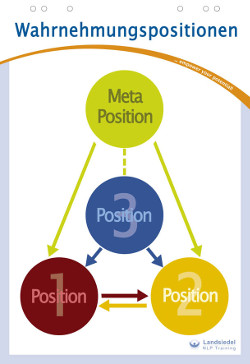Perceptual Positions 1-2-3
Position 1
In this position, you are fully in your own body — seeing through your own eyes and hearing through your own ears. In this state, it’s often difficult to distinguish between description and evaluation because you are completely associated with your experience.
Position 2
This position, also called the referential index shift in NLP, involves identifying with another person. You perceive the world through the other’s senses and adopt their perceptual filters — even their physical sensations. This allows you to understand the intention behind their behavior, enhancing empathy and dramatically improving communication. It’s also a core process in modelling.
Position 3

This is a higher logical level. It’s often compared to that of a director observing a scene with calm detachment, sensory awareness, and flexibility — an external observer who sees and describes without judgment. This resource state enables optimal sensory access and processing of insights from both the first and second positions. It’s useful for reviewing a difficult situation as if watching a movie, improving your responses, and developing new behavioral patterns for the future.
To enhance behavioral flexibility, it’s essential to be able to move smoothly and appropriately among all three perceptual positions.
Our online academy offers a 90-minute webinar recording with trainer Joerg-Friedrich Gampper covering this topic. Click the “Watch Video” button below to access the full session.
Exercise for Positions 1-2-3
- Recall a challenging situation with someone with whom communication has been difficult.
- Step into Position 1 — fully associated — and relive what you thought, said, saw, heard, and felt.
- Then move to Position 2 — see yourself from the other person’s perspective. Hear what you said from their point of view, observe your behavior from the outside, and begin to sense what it feels like to be the other person.
- Next, step into Position 3 — the dissociated observer — and describe the situation objectively, as a behavioral researcher or neutral observer might. With these new insights, return to Position 1 and adjust your behavior accordingly. Continue moving between the positions until you are satisfied with the outcome.
- Finally, test your new perspective in real-life situations.
- Mark the three positions on the floor in a circle for easier navigation.
Integrating Perceptual Positions
Many limitations and communication challenges arise not from being stuck in one perceptual position, but from our representational systems being split across different positions. This split is often an unconscious attempt to solve a problem but can become a habitual pattern. Integrating all perceptual positions enhances personal congruence and allows you to access each perspective fully — leading to greater insight, empathy, and wisdom.
Part I
- 1. Identify a difficult situation involving another person.
- 2. Elicit and map your current perceptual position.
Visual: What do you see? Do you see yourself and the other person, or only the other person? From where do you view the scene? Are you seeing through your own eyes or from a shifted angle?
Auditory: What do you hear? Whose voices are present? Are they inner or outer voices? Where do they come from? What do these voices say?
Kinesthetic: What do you feel? Whose feelings are they — yours or the other person’s? Where are they located in your body? Are they neutral, resourceful observer feelings, or emotions linked to Position 1 or 2?
Part II: The Observer Position
- 3. Integration of the Observer Position
If the client primarily experiences Position 1, integrate the self-position first. Notice how each instruction toward integration changes the state, possibly triggering submodality shifts or belief adjustments. Observe how perception and emotional response evolve as a result.
Visual: Adopt a position from which you can see both yourself and the other person on equal footing, at eye level, from your own perspective as the observer.
Auditory: Hear both voices — yours and the other’s — directly from their true sources, as the observer. Use pronouns like “he,” “she,” and “they” to describe them neutrally.
Kinesthetic: Allow all non-observer feelings to flow back to where they belong — either to yourself or the other person. Ask your unconscious mind to redistribute emotions appropriately. Support the process with auditory and visual anchors.
As you do, notice how new, resourceful observer feelings emerge. Have both you and the other person shifted toward more resourceful states? What else has changed in your perception of the situation?

 Deutsch
Deutsch English
English Français
Français 中文
中文 Español
Español नहीं
नहीं Русский
Русский
